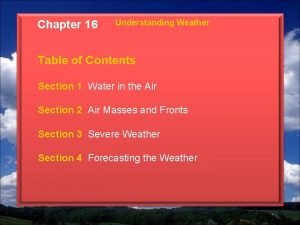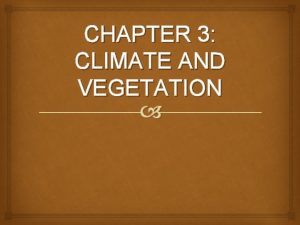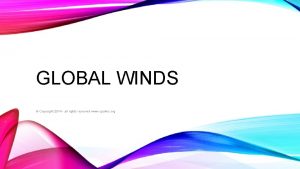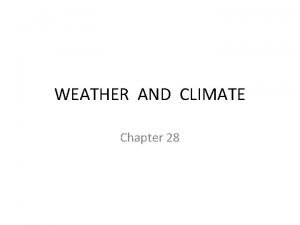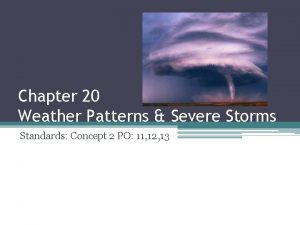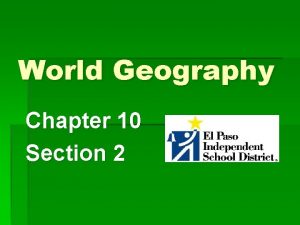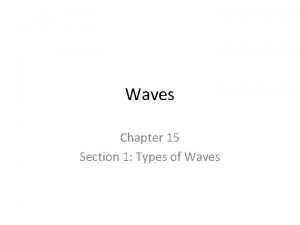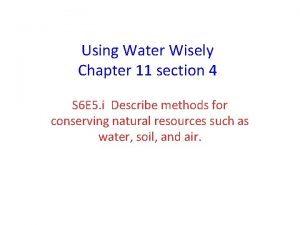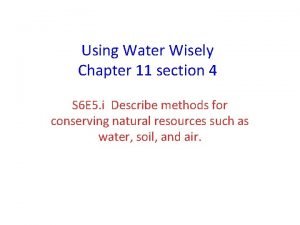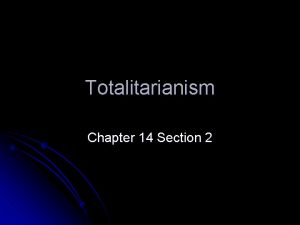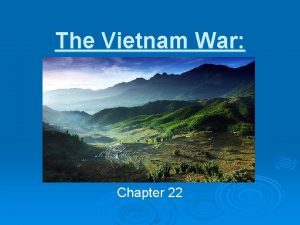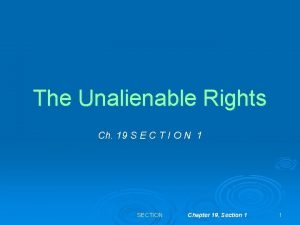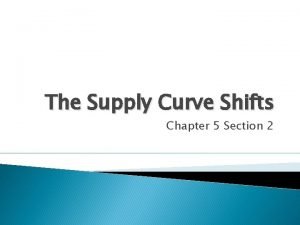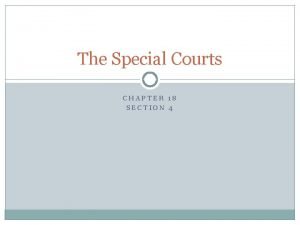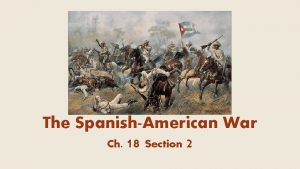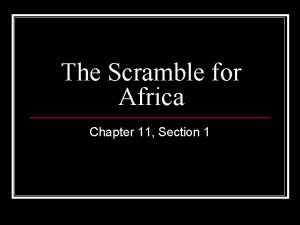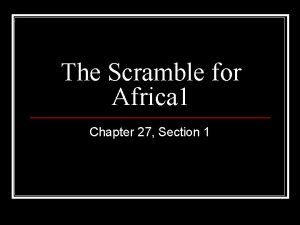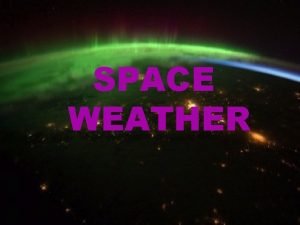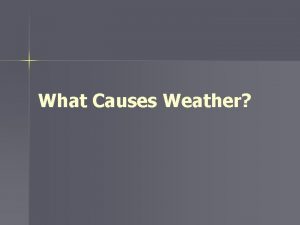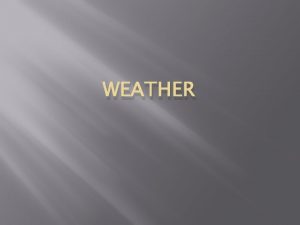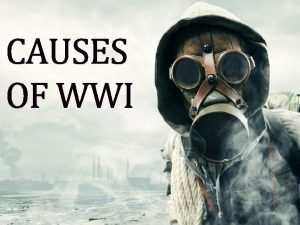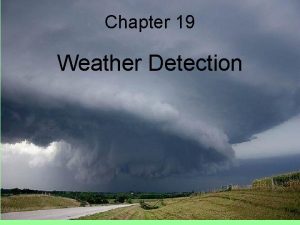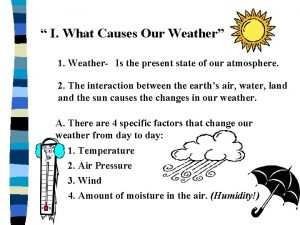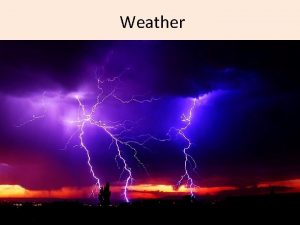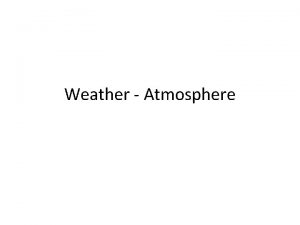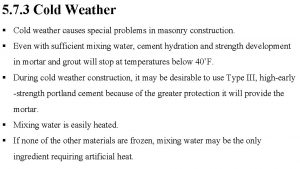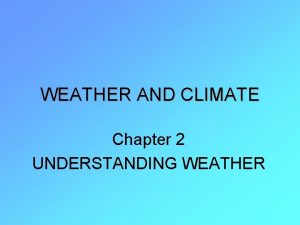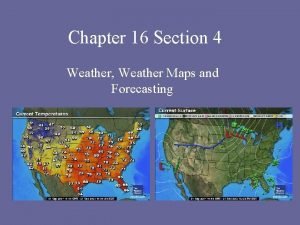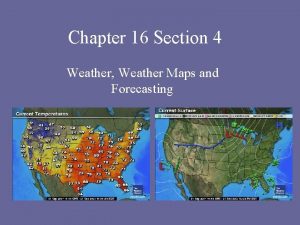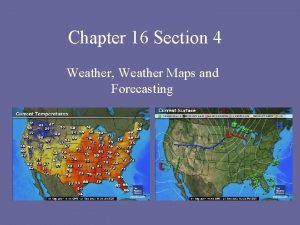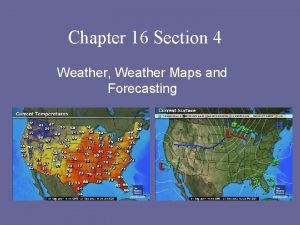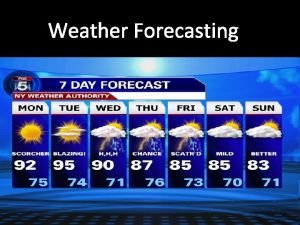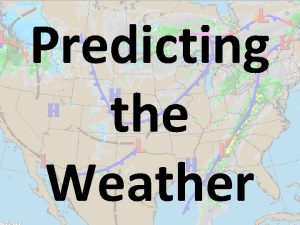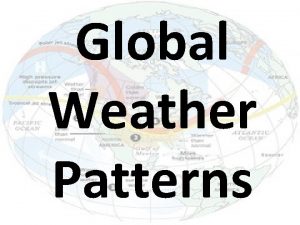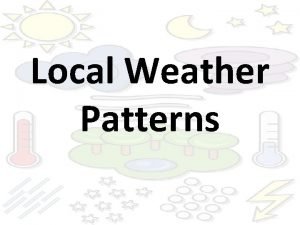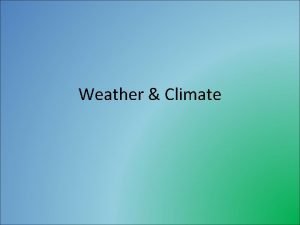Chapter 12 WEATHER Section 1 causes of weather












































- Slides: 44

Chapter 12 WEATHER

• Section 1 – causes of weather • Short term variation in atmospheric conditions are called weather. • Climate is the long-term average of variations in weather for a particular place. Climate takes into account the average of the past 30 years.

• The constant movement of air on Earth’s surface along with the oceanic currents, redistribute thermal energy around the Earth. Weather is part of the constant redistribution of Earth’s thermal energy.

• An air mass is a large volume of air that has the same characteristics as its source region. The source region is the area over which the air mass formed.

• There are 5 types of air masses. 1. ARCTIC – source region above 60 N latitude, results in cold, dry air.

2. Continental Polar – (continental means its occurs over land) origins are Canada and Alaska. Results in cold, dry weather.

3. Maritime Polar – (maritime means ocean) develops over the Northern Pacific or Atlantic. Results in cool to mild, humid weather.

4. Continental Tropical – develops over Southwestern U. S. and Mexico. Results in hot, dry weather.

5. Maritime Tropical – develops over tropical seas, results in warm, humid weather.

• Air mass modification – when an air mass travels over land or water that has different characteristics from where it developed, it can take on some of those characteristics.

• When an air mass undergoes modification it exchanges thermal energy and /or moisture with the surface over which it travels.

• Section 2 – Weather Systems • The direction of Earth’s winds are influenced by Earth’s rotation. This is called the Coriolis effect and results in fluids and objects moving in a curved path rather than a straight path.

• Global wind systems help equalize thermal energy on Earth.

• There are 3 basic wind systems. 1. Polar Easterlies – begins as cold air sinks and turns east, usually cold, weak and sporadic.

2. Prevailing westerlies – moves west toward the poles. Steady winds that move most of the weather across the U. S.


3. Trade Winds – air sinks and moves east toward the equator. The horse latitudes are a band of weak winds resulting from the sinking of the trade winds.

• The areas where the wind systems meet influence weather because of how air masses of different temp and pressure interact.

• Jet Stream – a narrow band of fast moving wind in the upper atmosphere. • The speed of the jet stream can reach 250 miles per hour.

• Fronts – when two air masses collide Cold fronts – when cold, dense air displaces warm air which is less dense. Heavy precipitation and storms are associated with cold fronts.


• Warm front – when advancing warm air displaces cold air.

• Stationary front – when 2 air masses meet but neither advances.

• Occluded front – when a fast moving cold air mass pushes a warm air mass up because there is another cold air mass in front of it. Heavy rains and storms can occur.

• Pressure Systems • Low Pressure systems – associated with rising air being replaced by air rushing in to take its place. Characterized by cloudy weather and rain. • Air spins counter clockwise.

• High pressure systems – sinking air pushes surface air out of the way. They are associated with fair weather. • Air spins clockwise.


• Section 3 – Gathering Weather Data • Thermometer – measures temperature • Barometer – measures air pressure • Anemometer – measures wind speed • Hygrometer – measures humididty

• A radiosonde is used to gather information from the upper atmosphere. It is a package of sensors and a battery powered radio transmitter suspended from a balloon.



• Doppler radar – measures the speed at which precipitation moves toward or away from a radar station. Good at detecting rotation associated with tornados.



• Weather satellites – • Use infrared imagery to detect differences in thermal energy. • Also used to measure water vapor that help define and identify air currents.


• Section 4 – Weather Analysis and Prediction • A station model is a record of weather data for a particular site at a particular time.


• Lines of equal pressure are called isobars. • Lines of equal temperature are called isotherms.


• Types of forecasting • Digital – created by applying physical principles and mathematics to the atmospheric variables and making predictions about how they will change over time. This is the main method used today.

• Analog – based on comparison of current weather patterns to similar patterns from the past. It is called analog because forecasters look for analogous patterns between past and current conditions.

• How good are forecasts? • A one to three day forecast is usually accurate for expected temperatures and for when and how much precipitation can be expected.

 Chapter 12 section 1 what causes air pollution
Chapter 12 section 1 what causes air pollution Chapter 12 air section 1 what causes air pollution
Chapter 12 air section 1 what causes air pollution Proximate cause and ultimate cause
Proximate cause and ultimate cause Ultimate and proximate causes of behaviour
Ultimate and proximate causes of behaviour Chapter 16 section 1 water in the air answer key
Chapter 16 section 1 water in the air answer key Humid continental def
Humid continental def Cpalms what causes weather
Cpalms what causes weather Section quick check chapter 10 section 1 meiosis answer key
Section quick check chapter 10 section 1 meiosis answer key Weather symbols chart
Weather symbols chart Tongue twisters about spring
Tongue twisters about spring Weather the weather poem
Weather the weather poem It's rainy and windy
It's rainy and windy Whether the weather
Whether the weather Heavy weather by weather report
Heavy weather by weather report Capital weather gang weather wall
Capital weather gang weather wall This view represents
This view represents A revolved section is drawn for
A revolved section is drawn for Half section view drawing
Half section view drawing What is the definition of chemical potential energy
What is the definition of chemical potential energy Chapter 20 weather patterns and severe storms
Chapter 20 weather patterns and severe storms Describe the weather at the beginning of chapter 28
Describe the weather at the beginning of chapter 28 How does wind affect weather and climate
How does wind affect weather and climate Chapter 20 weather patterns and severe storms
Chapter 20 weather patterns and severe storms Chapter 17 section 3 world history
Chapter 17 section 3 world history Chapter 30 section 2 world history
Chapter 30 section 2 world history What was the counter-reformation?
What was the counter-reformation? Chapter 10 section 2 central america and the caribbean
Chapter 10 section 2 central america and the caribbean Chapter 14 section 1 work and power
Chapter 14 section 1 work and power Chapter 19 section 4 wilson fights for peace
Chapter 19 section 4 wilson fights for peace Chapter 15 section 1 types of waves answers
Chapter 15 section 1 types of waves answers Chapter 24 section 2 watergate answers
Chapter 24 section 2 watergate answers Chapter 11 section 4 using water wisely answer key
Chapter 11 section 4 using water wisely answer key We think we are using water wisely because
We think we are using water wisely because 5 determinants of supply
5 determinants of supply Chapter 5 section 4
Chapter 5 section 4 Turmoil and change in mexico
Turmoil and change in mexico Chapter 14 section 2 totalitarianism
Chapter 14 section 2 totalitarianism Chapter 22 section 5 the end of the war and its legacy
Chapter 22 section 5 the end of the war and its legacy Chapter 19 section 1 the unalienable rights
Chapter 19 section 1 the unalienable rights Chapter 5 section 2 the supply curve shifts
Chapter 5 section 2 the supply curve shifts Chapter 18 section 4 the special courts
Chapter 18 section 4 the special courts Chapter 18 section 2 the spanish american war
Chapter 18 section 2 the spanish american war Chapter 11 section 1 the scramble for africa
Chapter 11 section 1 the scramble for africa Chapter 27 section 1 the scramble for africa
Chapter 27 section 1 the scramble for africa Chapter 6 the scientific revolution
Chapter 6 the scientific revolution




